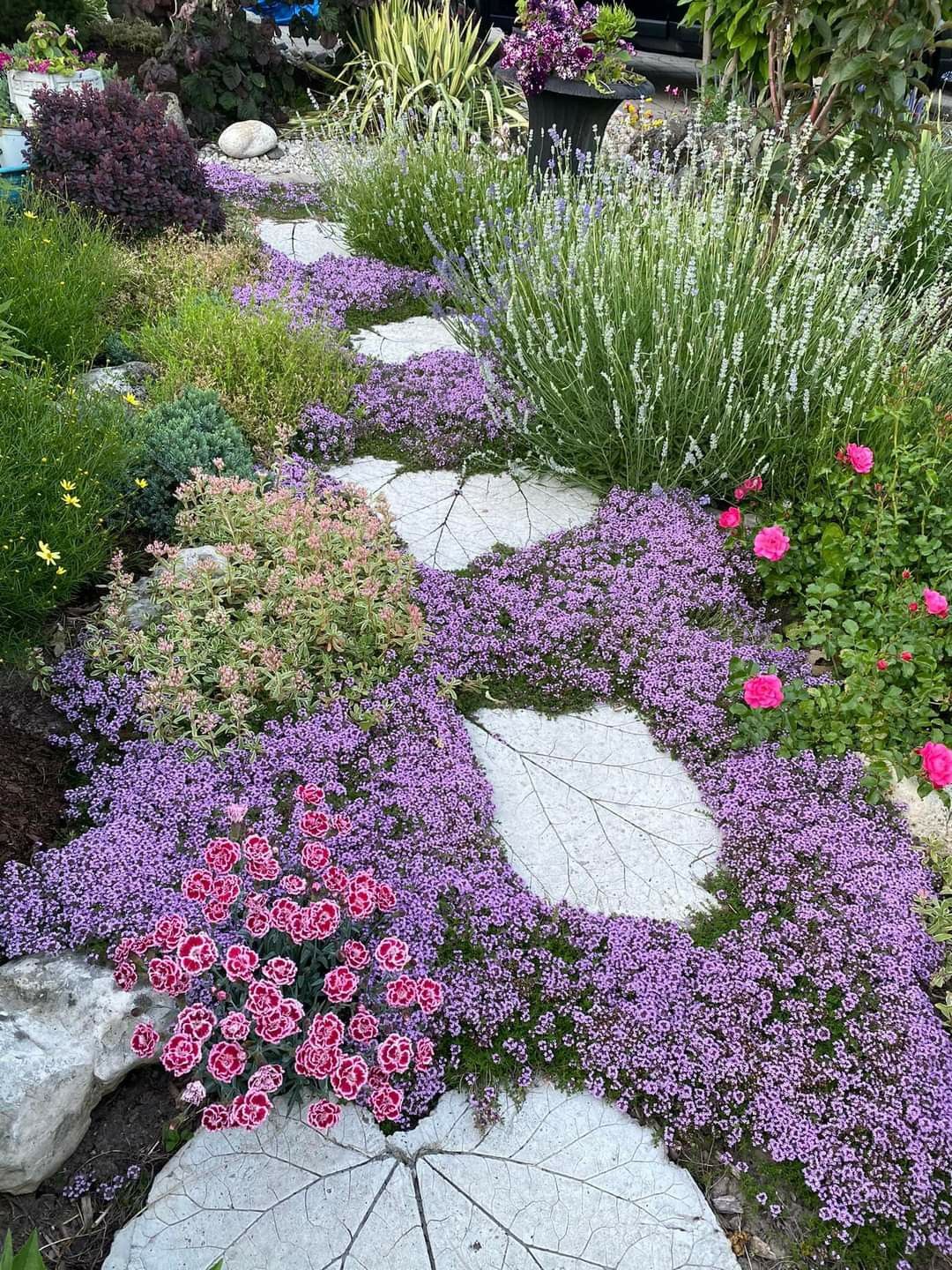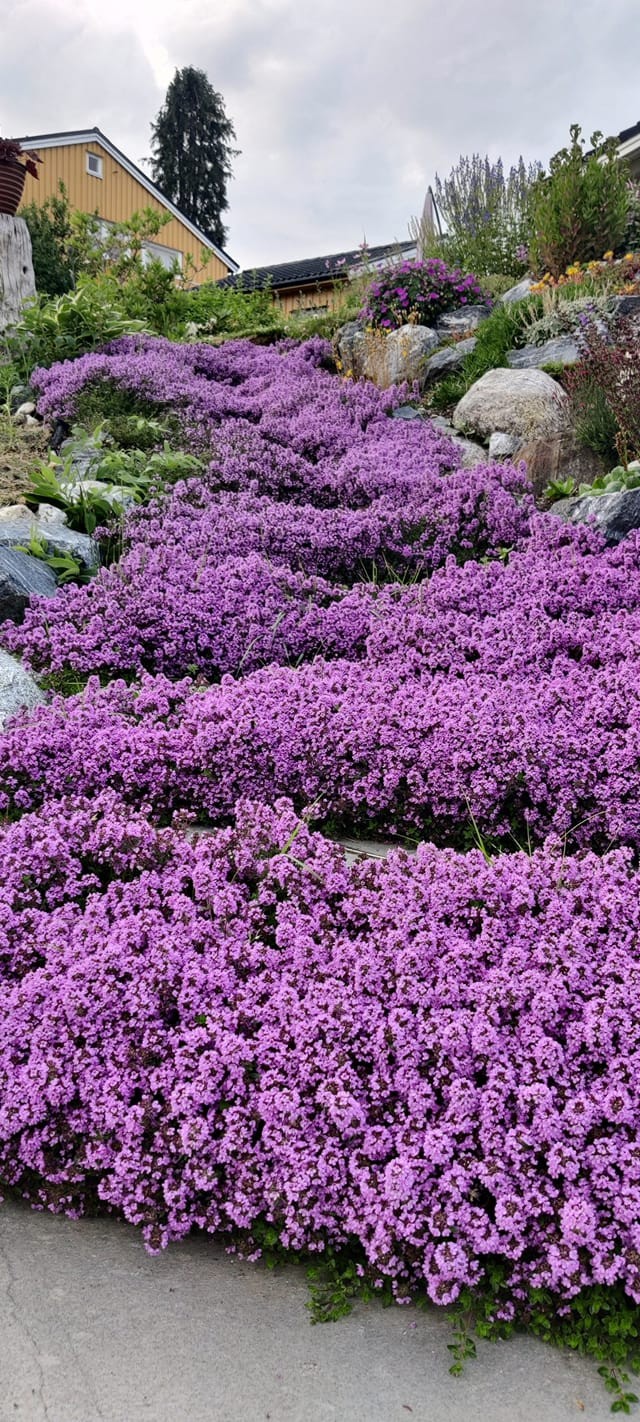Does taking care of a grass lawn seem like a nightmare since watering, mowing, and performing general maintenance is labor-intensive and time-consuming?
The good news is that you do not have to plant grass in your yard since there are multiple ground cover types, including growing a creeping thyme lawn, also known as “Mother of Thyme” or “Thymus serpyllum.”
Creeping thyme creates a fragrant, thick carpet once it matures. When it blossoms, you will be the envy of your neighborhood because the flowers can be white, red, pink, or purple thyme lawn.
However, before you can enjoy the beauty of the creeping thyme lawn, you have to plant it first.
Can Creeping Thyme Be Used As A Lawn?

Yes, creeping thyme makes an excellent ground cover for lawns, serving as a great grass lawn alternatives.
Besides being beautiful, it’s drought-resistant – it can survive harsh seasons and require little watering after establishment.
Related Posts:
The perennial shrub thrives in rocky and sandy soil and climates that receive full sunlight.
Pros of Creeping Thyme Lawn
These are advantages of a creeping thyme lawn.
1. It’s Suitable for Any Climate
Grass lawns do not stay green throughout the year; in fact, your lawn will look unattractive in summer.
On the flip side, creeping thyme requires minimal watering to survive. It keeps thriving even in summer and winter because it is moisture and frost-resistant.
Related Posts:
2. You Do Not Need to Replant
Since creeping thyme is a perennial plant, it does not die yearly but rather lives for over years. Additionally, since it spreads and grows continuously, you don’t need to replant it annually.
3. Beautiful
A lawn covered with creeping thyme can resemble a tiny blanket, with lovely blossoms that look aesthetically awesome and feel great on your feet.
Depending on the creeping thyme variety you plant, your yard will be covered in white, pink, purple, or red blossoms during peak periods.
4. Easy to Maintain
A creeping thyme lawn is pretty straightforward to maintain since you only have to water it only when the rainfall isn’t adequate.
Additionally, since it produces a low-growing cover that spreads laterally and grows between 2 to 4 inches high, there is no need to mow it. You can have your lawn looking natural for years without trimming it.
Moreover, this lawn can grow without requiring fertilizers.
5. Pollinator-friendly
The flowers of creeping thyme are highly attractive to pollinators like bees and butterflies, making it a beneficial addition to any garden.
6. Supports Wildlife
The scented creeping thyme plant flowers form nectar which butterflies and bees are attracted to. Also, it gives them habitat.
7. Discourages The Growth Of Weeds
Since creeping thyme forms a carpet-like ground cover, choking out weeds, giving you a weed-free, beautiful lawn.
8. It’s Mosquitos, Rabbits, and Deer-Resistant
Consider planting creeping thyme on your lawn if you want to keep out mosquitos, rabbits, and deer. This is because the plant’s aroma repels them.
9. Emits a Pleasant Scent
Creeping thyme produces a pleasant fragrance, making your lawn smell amazing, unlike turf or artificial grass lawns, which can generate unpleasant smells.
Cons of Creeping Thyme Lawn
Below are the disadvantages of creeping thyme lawn.
1. Expensive to Install
The installation costs of a creeping thyme lawn are high, surpassing the cost of installing plugs or sods. This is why it is not usually grown in large spaces.
2. Unsuitable for High Foot Traffic
Heavy foot traffic damages a thyme lawn, but it can tolerate moderate or low foot traffic.
3. Prone to Root Rot
Thyme roots rot if the lawn is overwatered or has poor soil drainage.
4. Needs Direct Sunlight
Thyme isn’t the best ground cover if your lawn is shady.
5. Vulnerable to Destructive Insects
Thyme doesn’t repel damaging insects like spider mites, aphids, and bees, so you need to invest in an insect repellent.
Furthermore, many bees will come to your lawn due to thyme.
How To Plant Creeping Thyme Lawn
While establishing a creeping thyme lawn isn’t complex, it is more labor-intensive compared to installing turf.
Also read: Best foundation plants for the front of your house
It prefers soil with neutral or just a bit of alkaline PH (7 to 8), well-drained soils, and enjoys full sunlight, although it does not mind some shade.
1) Growing Creeping Thyme From Seeds
If you decide to establish your creeping thyme using seeds, you can sow them indoors in pots and then transplant them once they reach 2” to 4” tall.
Alternatively, you can plant by spread creeping thyme seeds directly into the ground.
If your lawn has grass, remove it before sowing the seeds. Non-selective herbicides are effective but not the most eco-friendly method.
Also read: Creeping charlie look alikes
On the other hand, blocking the sun from getting to the plants by spreading many newspapers or plastic paper that’s black smothers the grass and the other vegetation.
Follow these steps after removing the grass or if the lawn did not have any grass.
- Use post-emergent herbicides to remove weeds or hand-pull them.
- Clear debris (stalks, stones, dirt, among others), then loosen the soil by raking it.
- Spread the creeping thyme seeds about 1/16 inch deep and space them approximately 8 inches to 12 inches to provide enough spreading room.
- Spread a thin layer of soil over the seeds to safeguard them from wind and predators and facilitate sunlight penetration.
- Water the lawn 2 to 3 times daily, ensuring the soil is continuously wet without being soggy.
Note
If you planted the seeds in a pot, have a container or tray with a lot of holes to facilitate proper drainage. The seeds will take 14 to 21 days to germinate.
Once the pot-planted creeping thyme seedlings reach around 2 inches, leave them outside during the day to absorb sunlight and take them back indoors when night comes to harden the plants.
Also read: Corsican Mint Lawn Pros And Cons
It takes creeping thyme a year to establish. After that, you only have to water it if the rainfall isn’t adequate..
2) Growing Creeping Thyme By Subdivision
This method entails dividing already matured creeping thyme’s rootballs and then replanting them somewhere else to generate new growth.
It is best to do this in the fall or spring.
Here’s how to grow creeping thyme by subdivision:
- Dig out around 3-4 inches of soil away from a healthy, mature creeping thyme’s center, remove the rootball and shake it to eliminate dirt.
- Subdivide the rootball into four parts using a sharp, sterile blade. Ensure each section contains sufficient roots.
- Replant the rootballs in a pot containing fresh soil or directly in the ground.
- Water 2 to 3 times every day to aid new growth.
Also Read: Sedum Lawn
Will Creeping Thyme Choke Out Grass?
Yes, creeping thyme has the potential to choke out grass if it is allowed to spread and establish itself vigorously. Its dense growth habit and mat-forming nature can suppress the growth of grass by competing for sunlight, nutrients, and water.
In addition, a lawn with short species of grass is more vulnerable to creeping thyme compared to one with tall grass since thyme does not grow over 3 inches.
Also read: Chamomile Lawn
The Best Creeping Thyme for a Lawn
Since there are many variants of thyme, you will need to choose the one that suits you most.
The truth is you are spoilt for choice when it comes to creeping thyme lawn.
The most common creeping thyme varieties are:
1. Red Creeping Thyme
A vigorous creeping variety with deep red foliage and clusters of pink or red flowers in the summer. It is the most common thyme variety used for creeping lawns.
2. Magic Carpet Thyme
The aromatic, dwarf sub-shrub forms a tight cushion made of dark-green tiny rounded leaves. It blooms profusely in early to mid-summer and remains evergreen during mild winters.
It spreads to 30 cm to 45 cm (12 to 18 inches) and grows to 2 cm to 5 cm (1 to 2 inches).
3. Elfin Thyme
The perennial low-growing shrub has a dense-mounding habit. It stays evergreen in mild areas and deciduous in colder climates.
It’s ideal for in-between bricks or pavers and rock gardens.
4. Creeping Golden Lemon
It produces greenish gold, shiny, lemon-scented, shiny leaves, and lavender flower spikes in summer.
5. Pink Chintz Thyme
This creeping thyme creates up to an 18” spread and is approximately 1 inch tall.
In mid-spring, it blooms, forming a salmon-pink flower carpet. Also, it tolerates sporadic foot traffic.
6. Wild Thyme
It has upright and prostrate forms. The foliages are variegated, gold, or green, with flowers ranging from purple to red.
7. Woolly Thyme
Its leaves are grey and are suitable for rock gardens and great for foot traffic.
FAQs
Are Thyme Poisonous To Dogs?
Thyme plants are not toxic to dogs, so your four-legged best friend can play around on your lawn without getting hurt.
Is Creeping Thyme Invasive?
Creeping thyme doesn’t have invasive roots, so it isn’t harmful to other plants.
Can you walk on creeping thyme?
Yes, you can walk on creeping thyme but keep the foot traffic moderate or low.
Where is the best place to plant creeping thyme?
The best place to plant creeping thyme is in a well-drained, sunny location. It can be planted in rock gardens, as a ground cover, in between stepping stones or pavers, or in a raised bed or container. It can also be used as a lawn alternative in low-traffic areas.
Conclusion
Creeping thyme is a versatile and low-maintenance ground cover that can add a pop of color, texture and fragrance to any lawn.
With a variety of options such as Elfin thyme, Lemon thyme, Woolly thyme and many more, you can choose the one that best suits your lawn needs.
Whether you’re looking for a lush green lawn or a stunning display of flowers, creeping thyme is the perfect choice for all your lawn ground cover alternatives.

Hey there, I’m Derek Schew, a writer for Lawnholic.com, where we cover everything and anything related to lawns. As someone who’s spent countless hours tending to my own lawn, I’m passionate about sharing my knowledge and helping others achieve the perfect yard. From lawn care tips to product reviews, I’m committed to providing our readers with the most accurate and up-to-date information available. So whether you’re a seasoned lawn enthusiast or just getting started, I invite you to join our community and discover the joys of a lush, green lawn.





I live in Rio Verde on 2 acres of dirt. I need green. I have a small area in front of our house and I put down fake turf. Looks beautiful. But, I just read it expels chemicals and now I need to get rid of it. Therefore, I want an easy maintenance free green ground cover, no flowers, not to attract bugs, easy for my dogs to romp around occasionally. What is your recommendation? Thank you
Hello Kathleen,
Considering your requirements for easy maintenance, no flowers, and a ground cover that is suitable for dogs, you might want to consider the following options:
1. Creeping Jenny
– This is a low-growing, trailing plant with vibrant green foliage.
– It’s easy to grow and requires minimal maintenance.
– Creeping Jenny is known for its ability to spread quickly and form a dense ground cover.
2. Liriope
– Also known as monkey grass, Liriope is a tough and adaptable ground cover.
– It forms clumps of grass-like foliage and is relatively low maintenance.
– Liriope is hardy and can tolerate a variety of soil conditions.
3. Asian Jasmine
– Asian Jasmine is an evergreen ground cover with small, glossy leaves.
– It’s a good choice for areas with partial shade and has a spreading growth habit.
– It’s a low-maintenance plant and can withstand moderate foot traffic.
Before making a final decision kindly, check with your local nurseries or gardening experts to ensure that the selected ground cover is well-suited to your specific climate and soil conditions in Rio Verde.